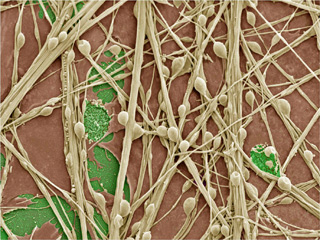
In this micrograph of neurons grown in culture, the tan threads are nerve cells, and the round tan beads are synapses, the connections that form between nerve cells. Changes in these connections are believed to underlie learning and memory (Image from the National Center for Microscopy and Imaging Research, National Institute of General Medical Sciences).
Instructor(s)
Dr. Lauren A. Makuch
Dr. Jaichandar Subramanian
MIT Course Number
7.343
As Taught In
Spring 2014
Level
Undergraduate
Course Description
Course Features
Course Description
How does the brain come to learn whether a stimulus is annoying, rewarding or neutral? How does remembering how to ride a bicycle differ from remembering scenes from a movie? In this course, students will explore the concept that learning and memory have a physical basis that can be observed as biochemical, physiological and/or morphological changes to neural tissue. Our goal will be to understand the strategies and techniques biologists use to search for the memory trace: the "holy grail" of modern neuroscience.
This course is one of many Advanced Undergraduate Seminars offered by the Biology Department at MIT. These seminars are tailored for students with an interest in using primary research literature to discuss and learn about current biological research in a highly interactive setting. Many instructors of the Advanced Undergraduate Seminars are postdoctoral scientists with a strong interest in teaching.


